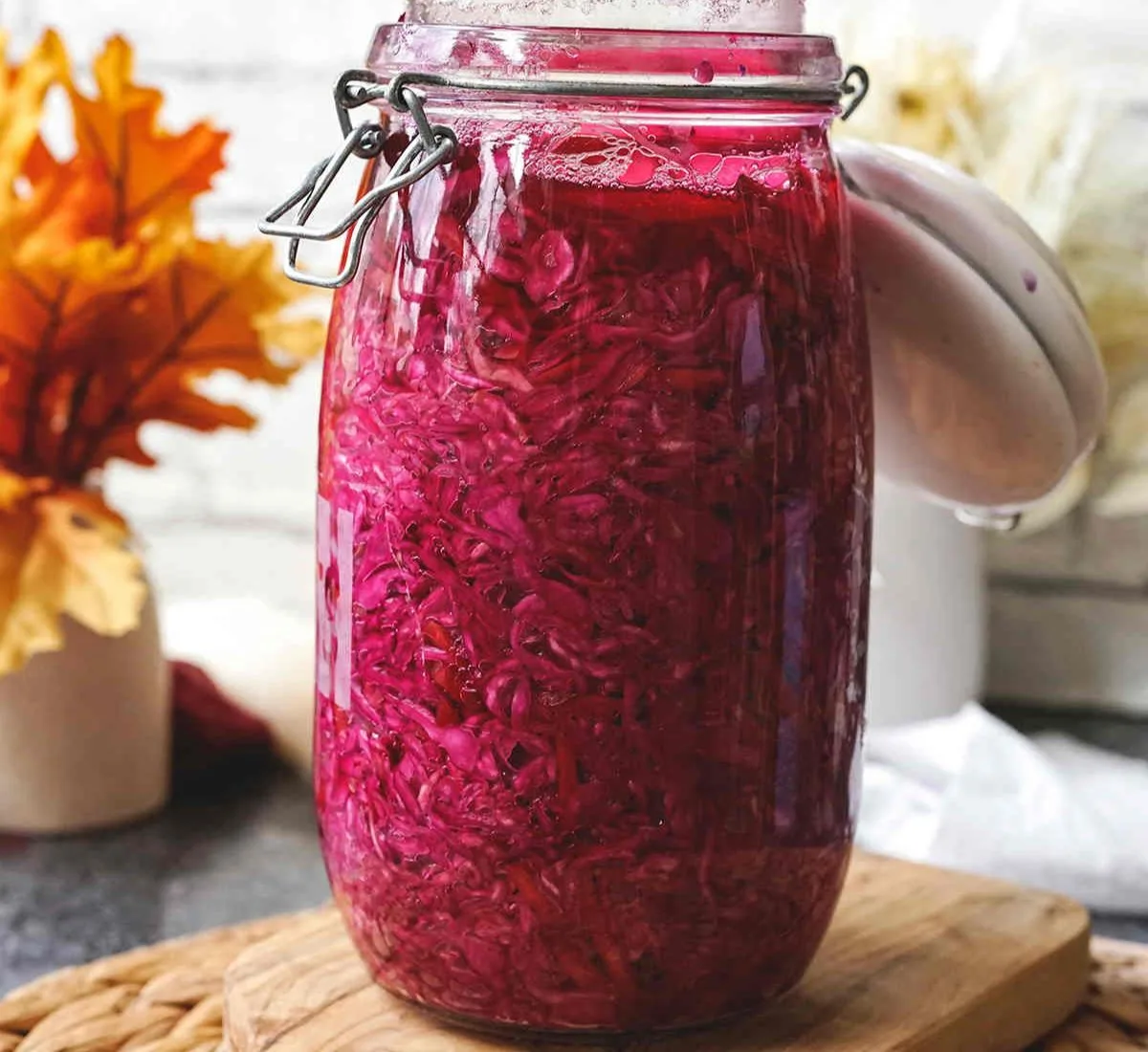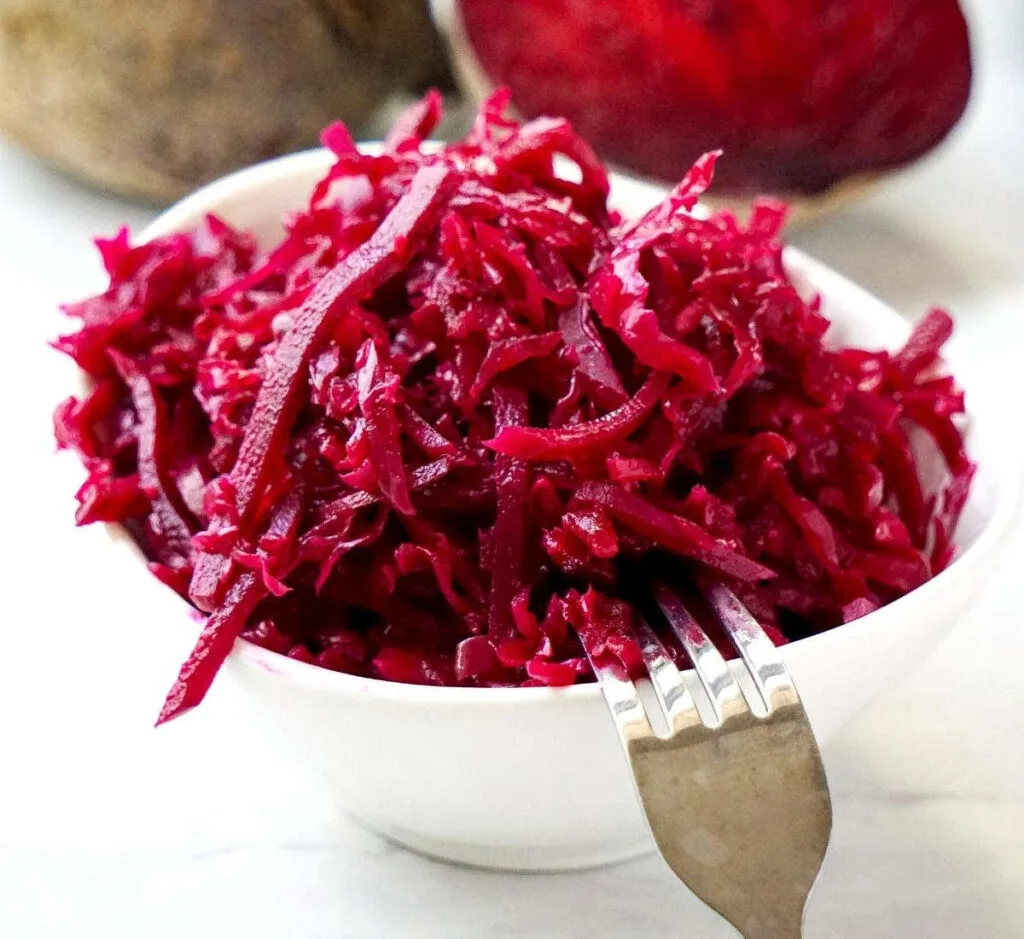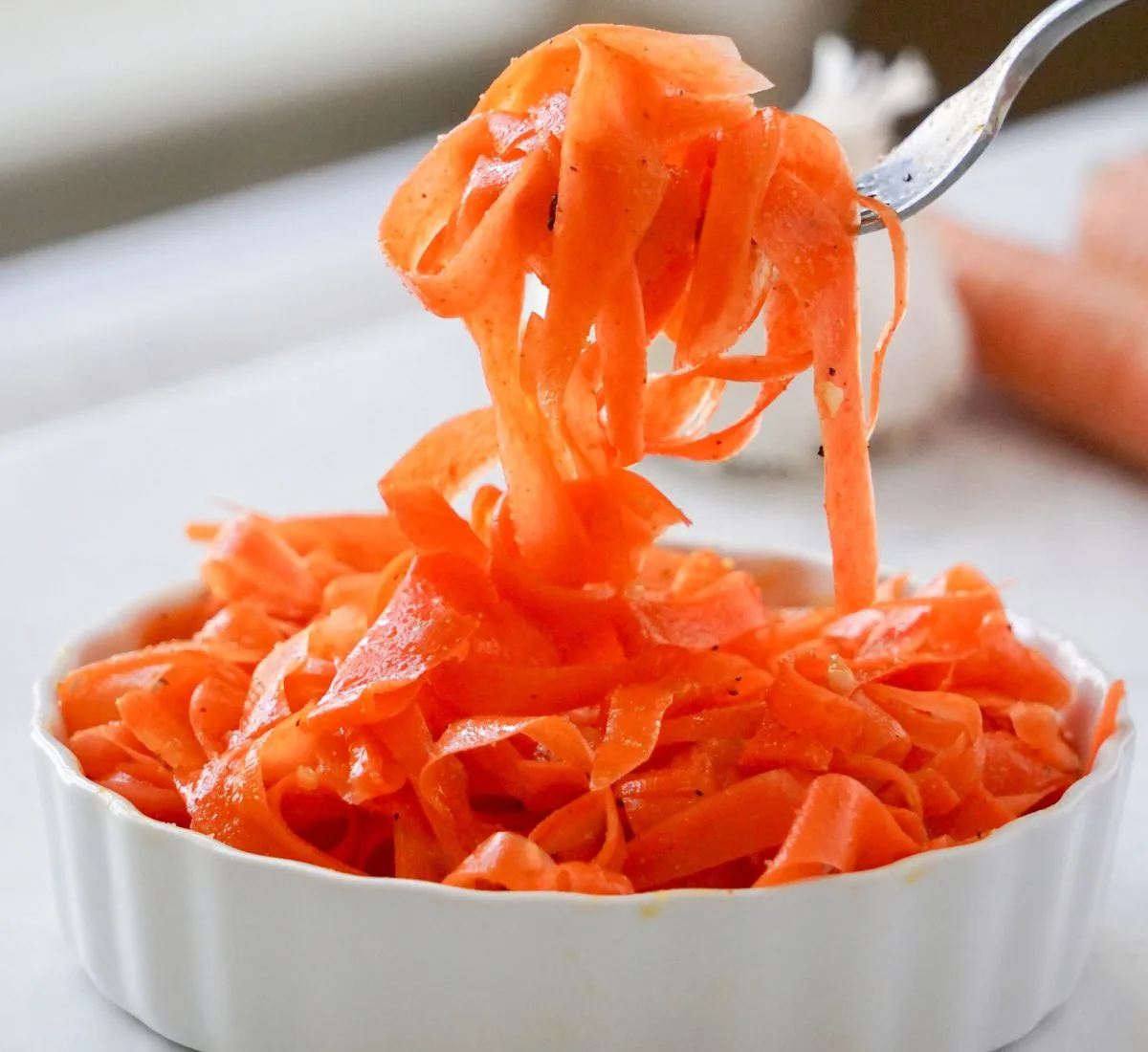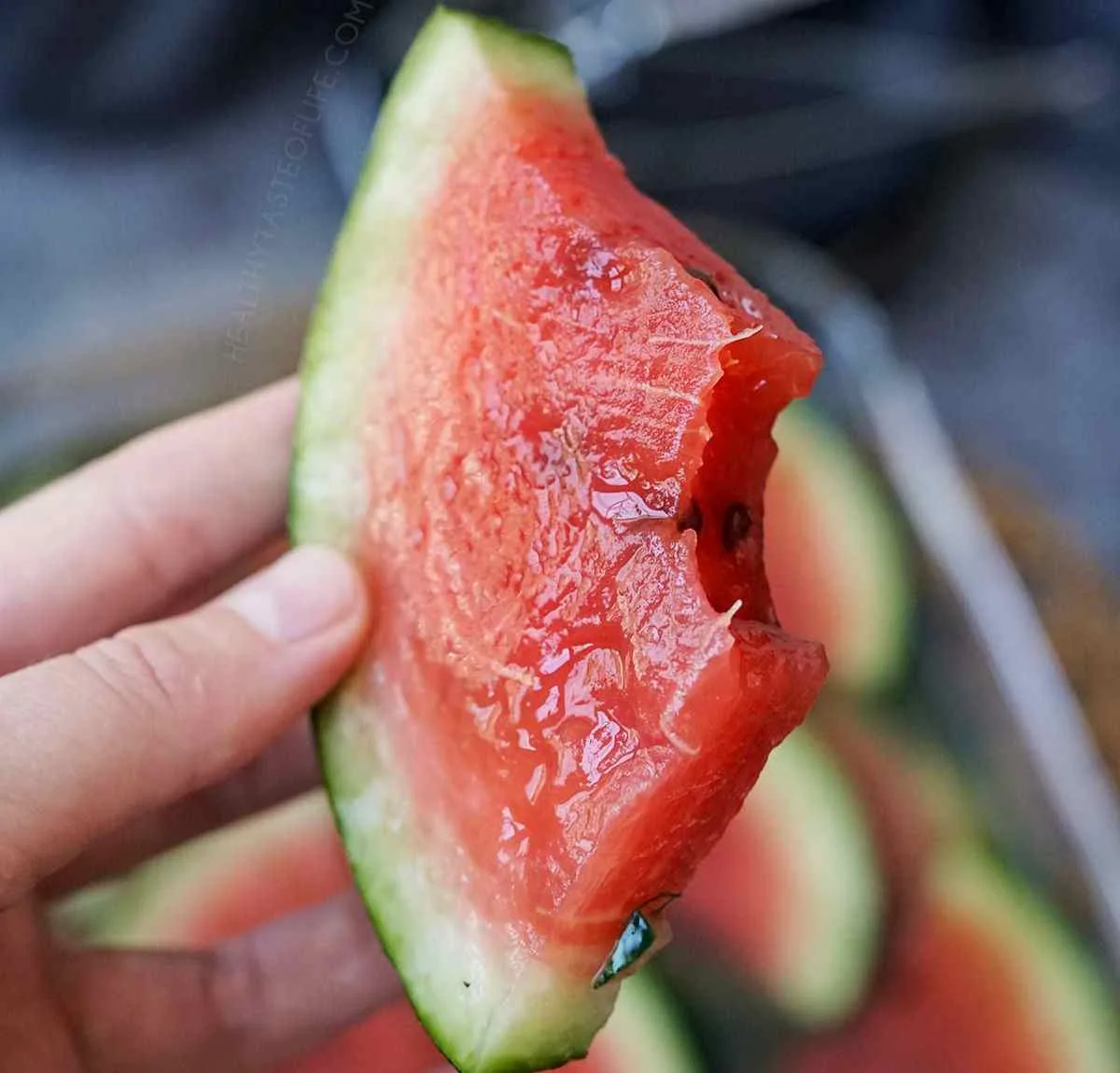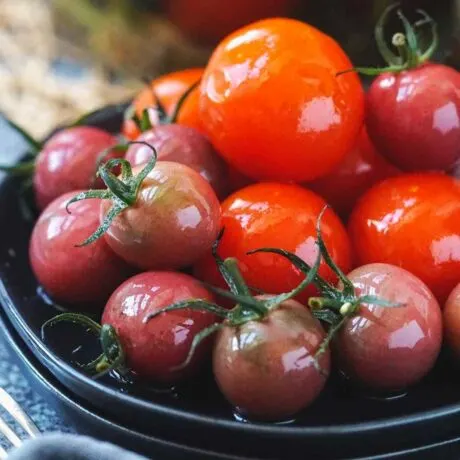Have you ever considered trying fermented tomatoes and giving them that delicious tangy twist? Whether you’re looking to experiment with fermenting tomatoes, searching for an authentic recipe for lacto fermented tomatoes, or simply finding creative ways of preserving tomatoes, this guide has got you covered.
From fermented cherry tomatoes to understanding how to ferment tomatoes in general with ease, prepare to immerse yourself in the complexities of fermentation and discover the benefits, steps, and uses of this ancient preservation method.
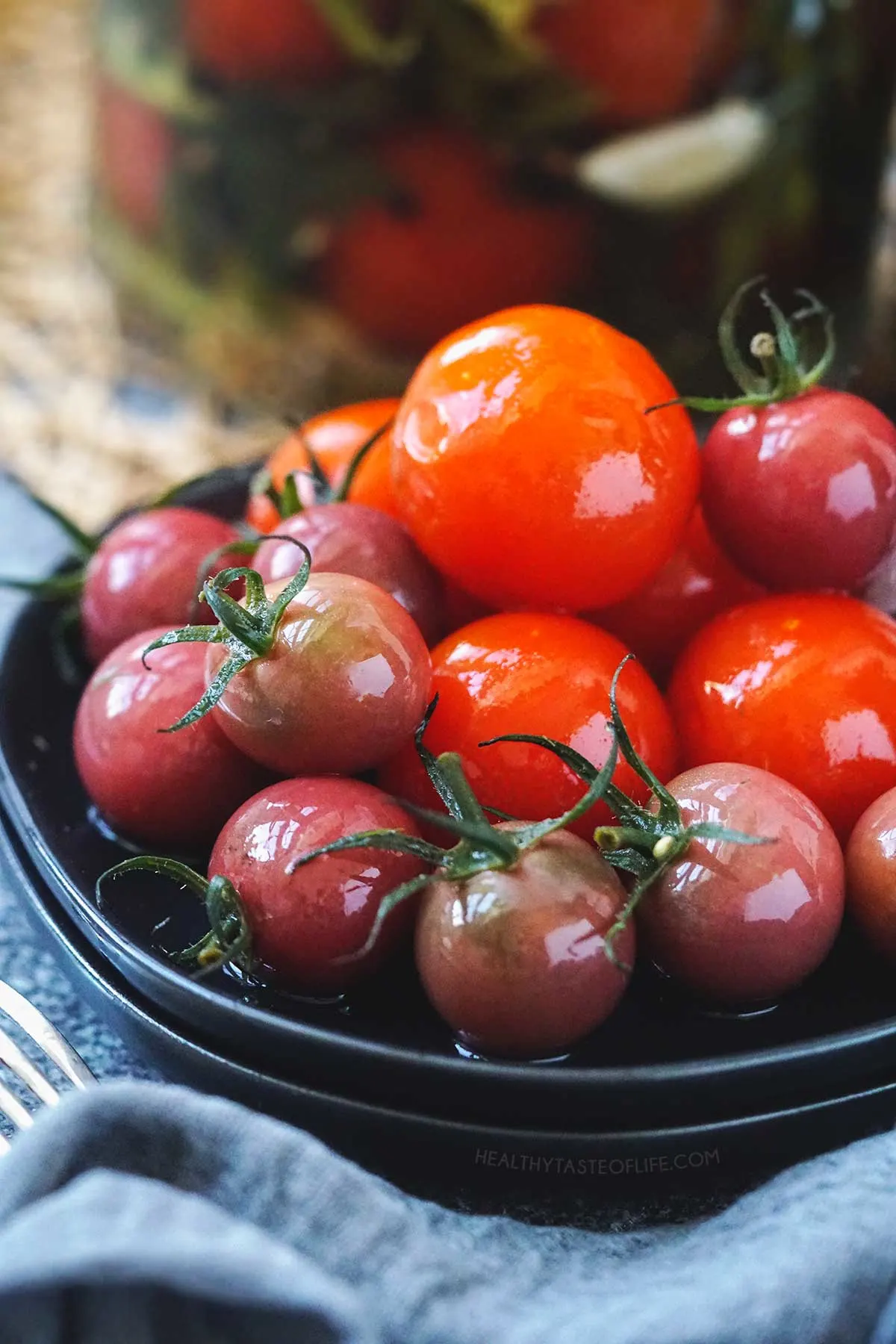
Swap in fermented tomatoes to elevate your dishes! Their tangy twist can transform your BBQ sauce, bring depth to marinara and add zest to relishes. Pair the pickled tomatoes with grilled meats, slip into burgers or veggie sandwiches, or sprinkle across salads for an unforgettable flavor.
Also consider alternating with the crisp bite of pickled dill cucumbers, fermented beets or fermented cauliflower, the rich zest of sauerkraut, fermented shaved carrot salad, or fermented watermelon.
Why Fermented Tomatoes
- A Taste Like No Other: Fermented tomatoes offer a tangy twist to the usual taste, with deeper, complex flavors.
- Nutritional Boost: Lacto fermented tomatoes are teeming with beneficial bacteria, making them a probiotic powerhouse.
- A Perfect Solution for Extra Tomatoes: If you have a surplus of tomatoes, especially cherry tomatoes, this is an excellent way of preserving them for future use.
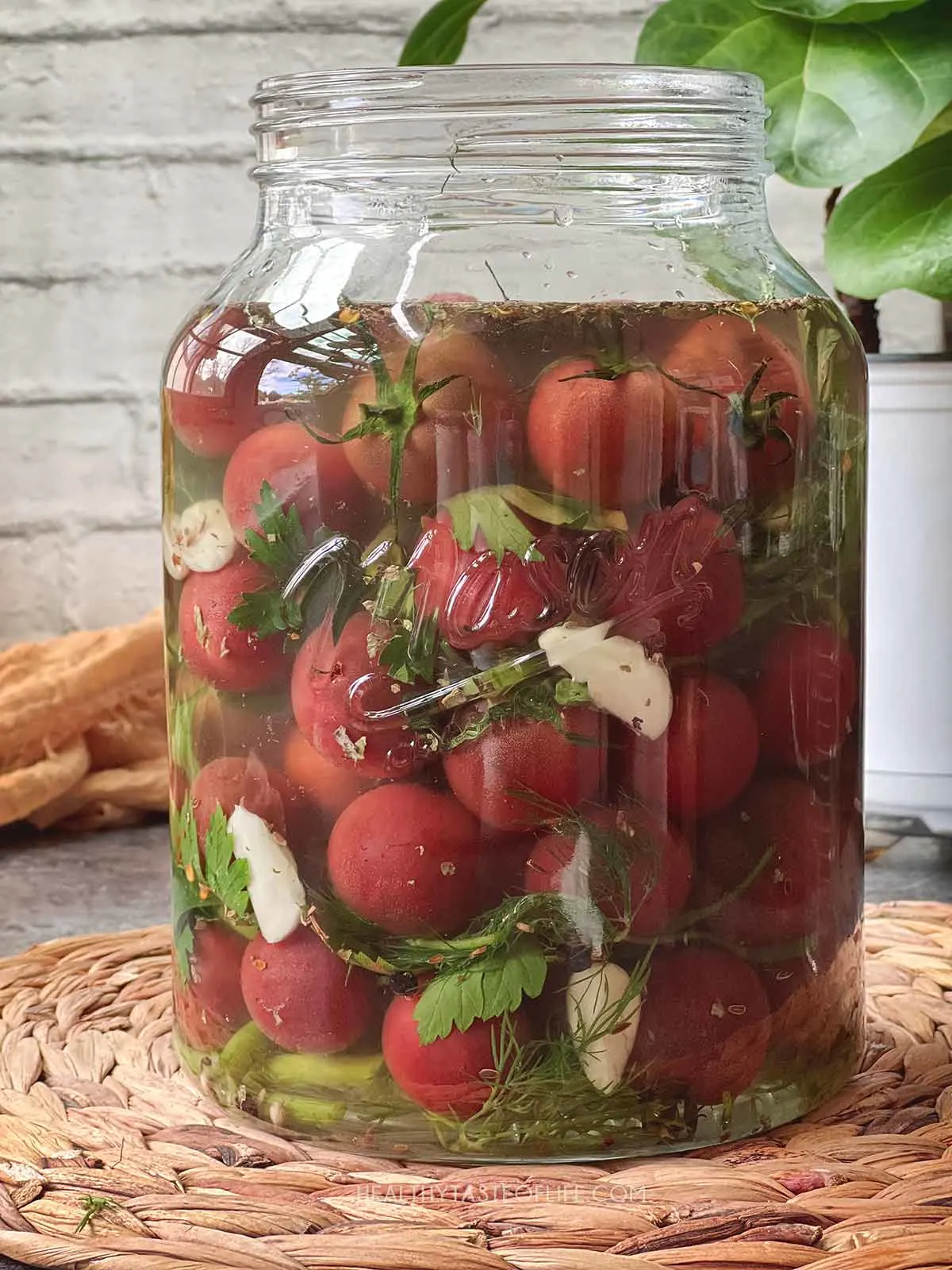
Related: Fermented Fresh Fish (Mackerel) Recipe
Ingredients Needed
- Tomatoes: Choose ripe, firm, and blemish-free tomatoes for best results. Cherry tomatoes are a popular choice due to their bite-sized nature, but any variety will work.
- Fermenting cherry tomatoes usually means quicker fermentation, a firmer bite due to their skin-to-flesh ratio, a potentially intensified flavor, and easier layering in jars compared to larger tomatoes, which might require piercing and careful placement for even fermentation.
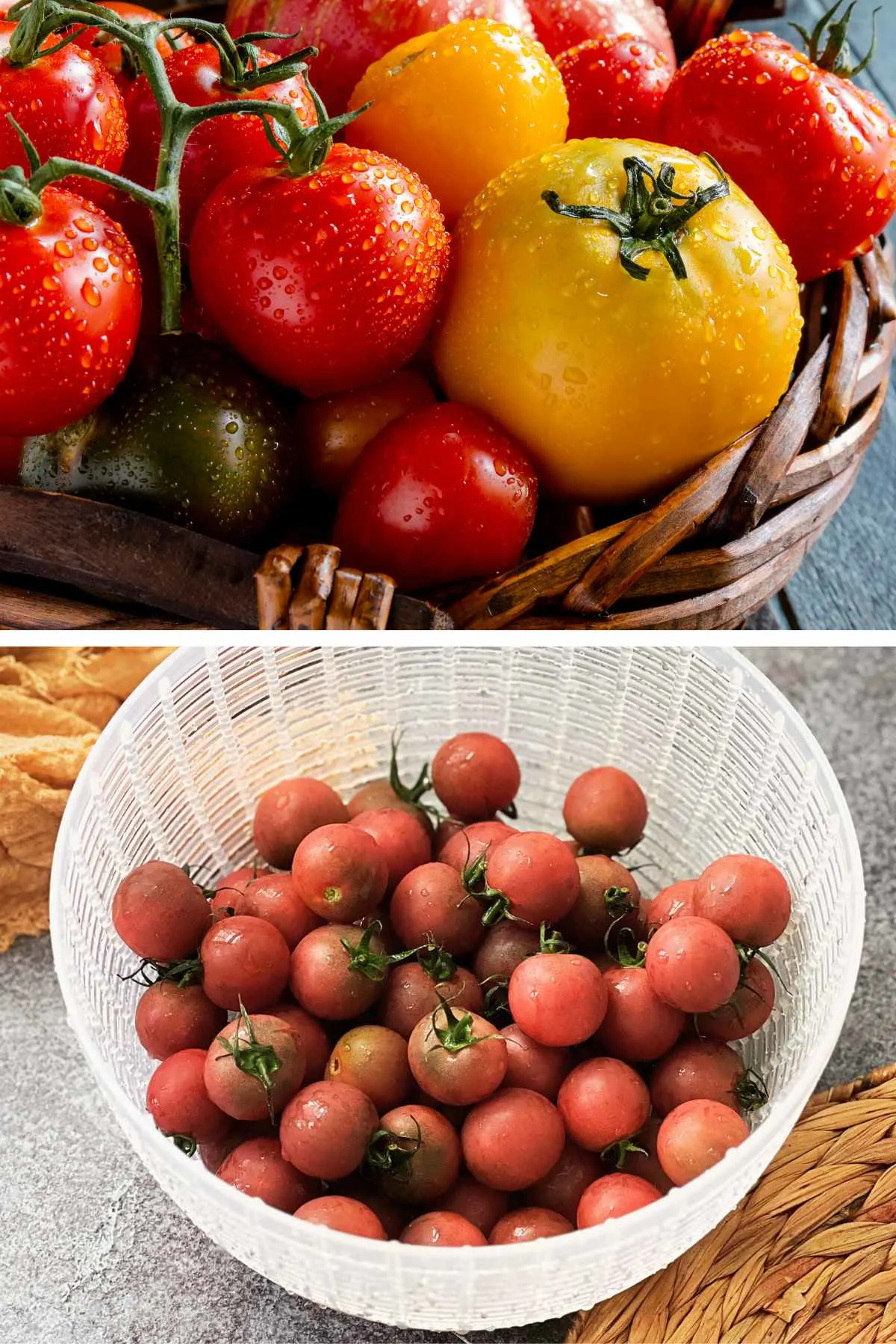
- Brine (Salt + Water): This fermentation method relies on the natural lacto-bacteria present on the tomato skin. The salt solution creates a brine that allows these good bacteria to thrive while keeping harmful bacteria at bay, preserving tomatoes and adding flavor. Sea salt or kosher salt without additives is ideal for fermenting tomatoes. And chlorine-free water ensures the beneficial bacteria thrive.
- Condiments and spices: can be added to enhance flavors and create unique taste profiles. Some popular additions include:
- Garlic: Whole cloves or thinly sliced ones can impart a strong, aromatic flavor.
- Onions: Thin slices or small onion wedges can be added for a hint of sweetness and depth.
- Ginger: Thin slices or grated ginger can give a zesty touch.
- Hot Peppers: Add a kick with whole, sliced, or crushed peppers.
- Herbs: Fresh or dried herbs such as basil, dill, thyme, rosemary, oregano, or bay leaves can be used.
- Spices: Mustard seeds, black peppercorns, coriander seeds, fennel seeds, caraway seeds, and juniper berries are popular choices.
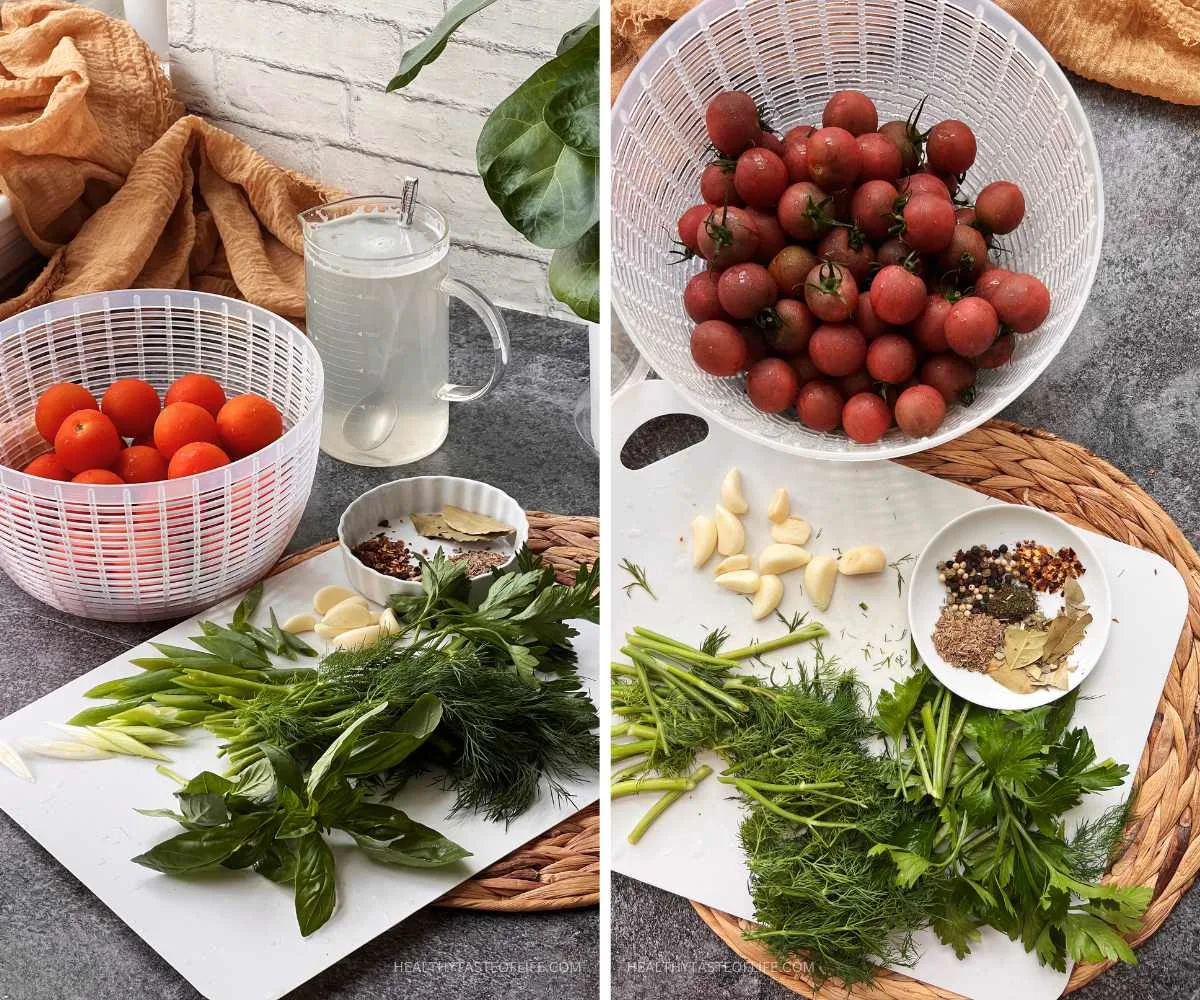
Tip For Choosing Your Tomatoes
For a successful ferment, opt for organic tomatoes. Ensure they’re free from blemishes and firm to touch. If possible, harvest them straight from your garden or purchase them from a trusted local source like an organic farmer’s market.
Step-by-Step Fermenting Process
- Cleanse: Wash the tomatoes gently but thoroughly.
- Preparation: If you have larger tomatoes, pierce each tomato with a clean skewer or a toothpick. This helps the brine penetrate better.
- Brining: Mix sea salt with water until dissolved.
- The salt-to-water ratio in a brine affects taste and fermentation speed. A 2-3% brine, made from 2-3 grams of salt per 100 milliliters of water, is commonly used for fermenting vegetables and offers a balance of flavor and preservation (you can drink it). A higher percentage, like 5%, yields a saltier brine that can slow down fermentation and enhance preservation but might be too salty for some tastes. I usually use a 2-3% brine for fermenting cucumbers, but here I like the tomatoes to be tangier and I’ll be using a 4% brine solution (2.4 tablespoons of sea salt in 4.2 cups of water which is ~1000 ml).

- Packing: Place the tomatoes in a sterilized jar (along with the spices or herbs if using, alternating in layers);
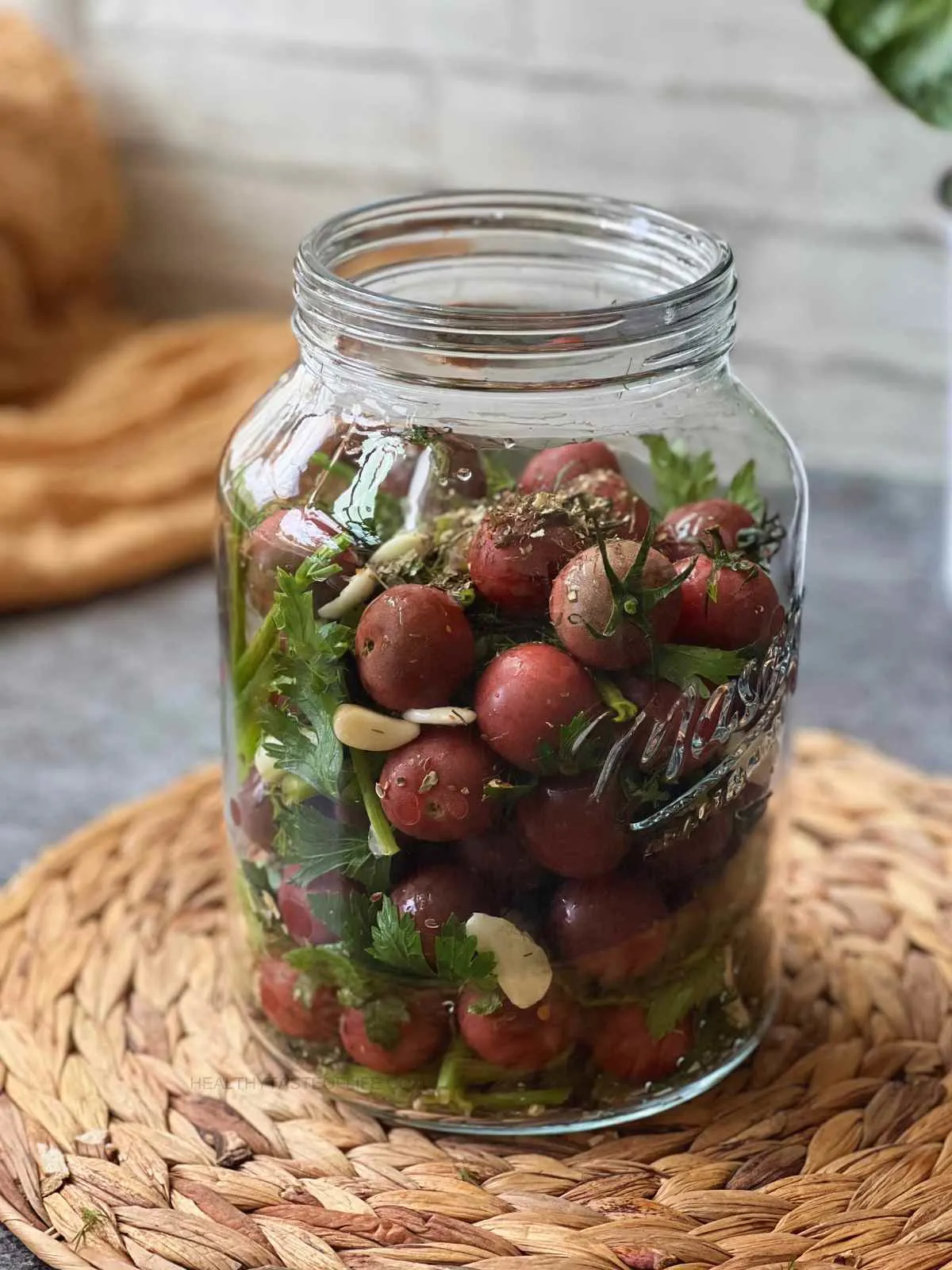
- Pour the brine, ensuring everyhting is submerged under.

- Seal: Use a fermentation weight to keep the tomatoes submerged. Seal the jar with a fermentation lid or cheesecloth to prevent any falling dust, dirt or insects.
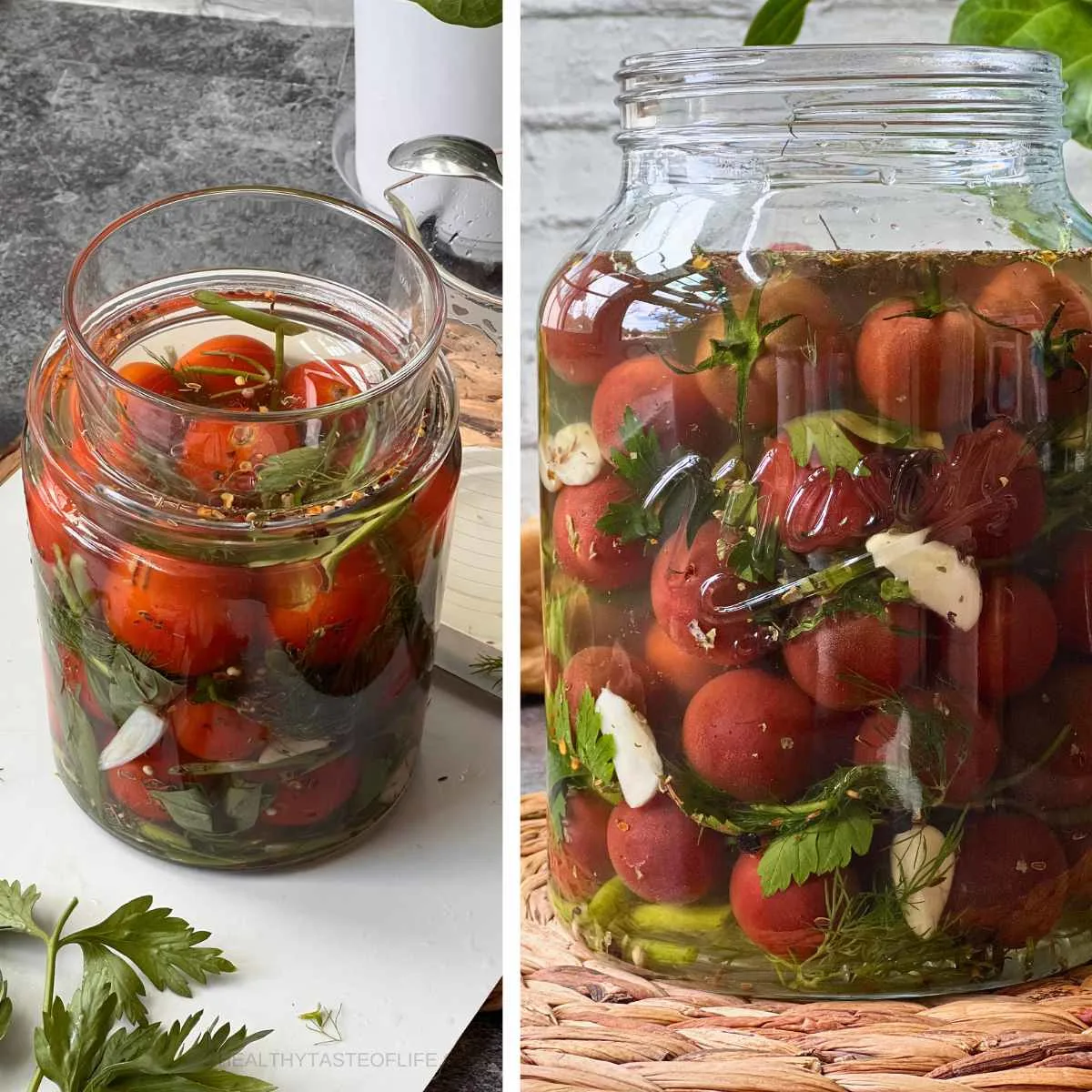
- Ferment: Store in a dark, cool place for 3-5 days, it depends on the temperature. A higher room teperature will speed up the fermentation process. Check daily to ensure tomatoes remain submerged and to release gas buildup. Give the jar a shake or two.
- Taste: Once they reach your desired level of fermentation, transfer to the refrigerator to halt the process.
Expert Tip
Adding a touch of sauerkraut juice to your brine can be a game-changer in fermentation! This juice is rich in beneficial lactic acid bacteria, which can kick-start the fermentation process and ensure a successful ferment. Not only does it introduce active probiotics, but it can also add a nuanced depth of flavor to your fermented tomatoes. Just a tablespoon or two is enough to give your brine that fermentation boost!

Tips to Keep Tomatoes Submerged in Brine To Prevent Spoilage
- Place a large grape leaf on top of the tomaties pushing it down to act as a barrier.
- Fill a smaller, clean jar with water, seal it, and place it on top inside the fermenting jar to weigh the tomatoes down.
- Or fill a Ziploc bag with water and place it on top of the tomatoes to act as a weight.
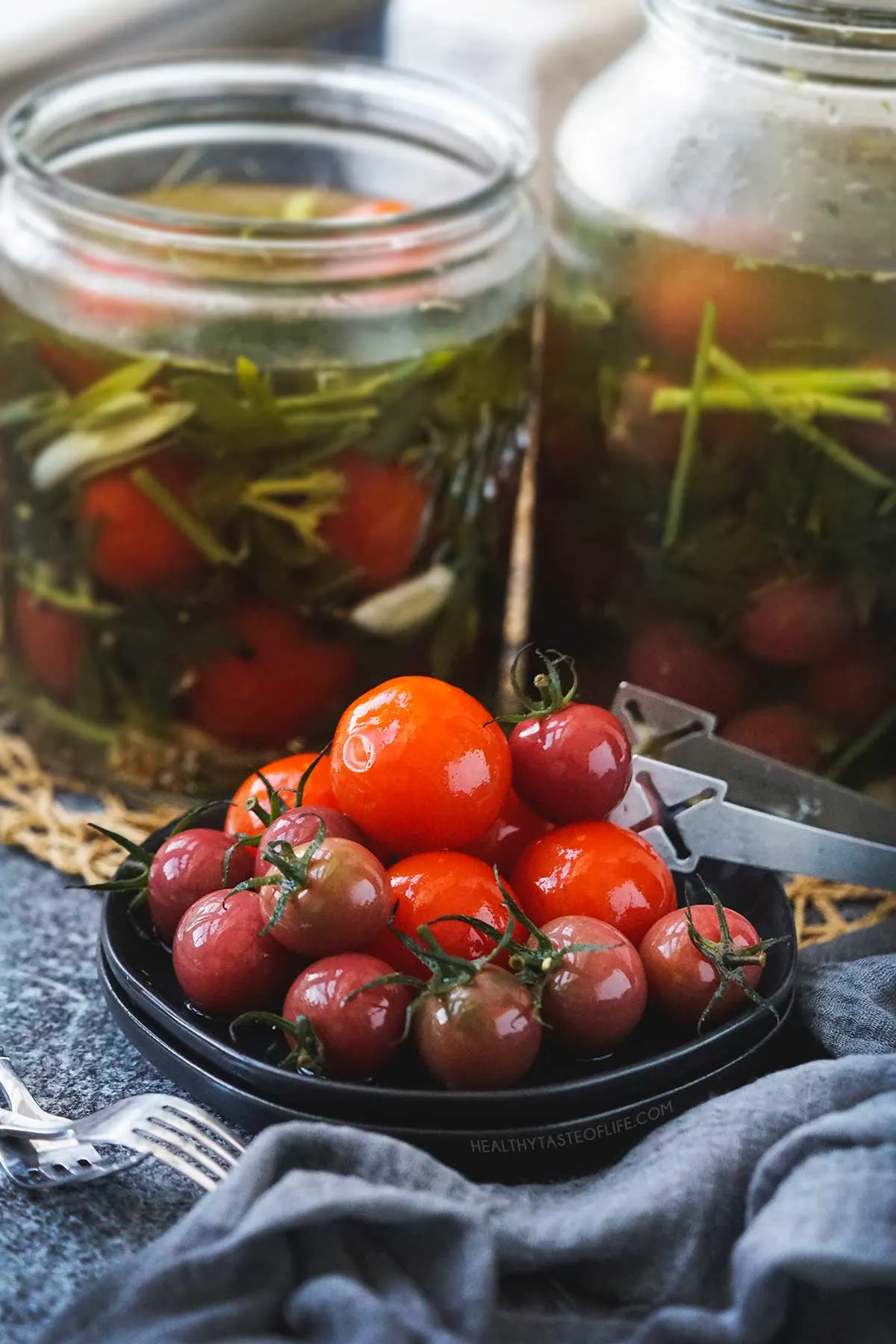
Storing and Shelf Life
Once fermented, store the tomatoes in the refrigerator. They will keep for up to 6 months, but it’s always a good practice to check for any off-putting smell or mold before consuming.
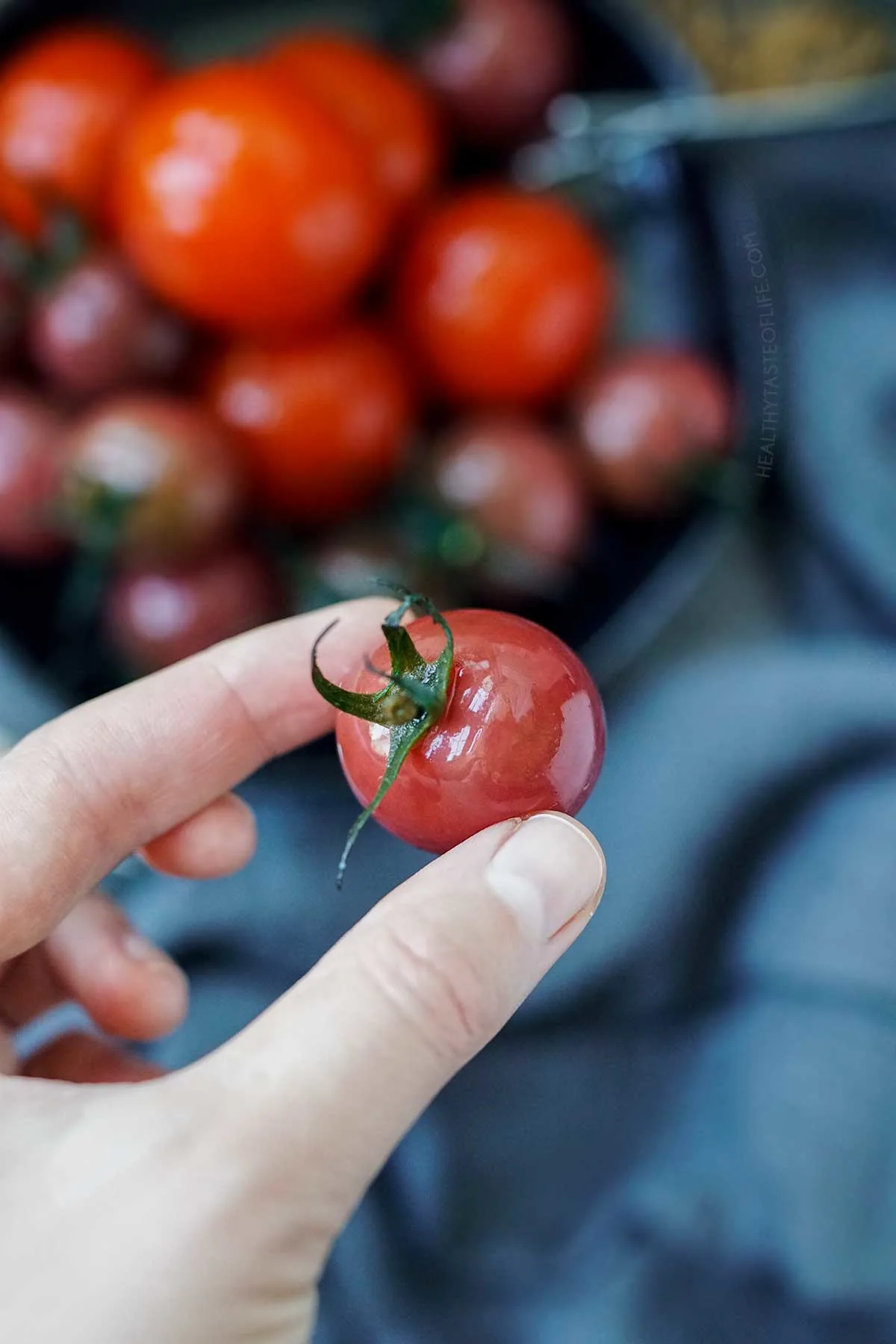
FAQs on Fermenting Tomatoes
Absolutely! Feel free to add garlic, basil, or other herbs and spices to flavor your ferment.
Over-fermentation or using overripe tomatoes can result in a softer texture. For firmer tomatoes, ferment for a shorter duration.
Fermented tomatoes have a tangy, slightly sour flavor compared to fresh tomatoes. The fermentation process deepens the flavor profile, adding complexity and a unique taste that many people find delightful.
The white residue sometimes seen on fermented foods is known as kahm yeast. While it might look concerning, kahm yeast is harmless. However, it can impart an off taste if left unchecked. Skim it off if you notice its growth to maintain the best flavor. Always be cautious and discard the ferment if you notice mold, which is different from kahm yeast and is harmful.
The fermentation time for tomatoes can vary based on factors like temperature and the size of the tomatoes. Generally, they can take anywhere from 3-7 days to start the fermentation process and mature in about 2 weeks. It’s always a good idea to taste them periodically to achieve your desired level of fermentation.
Any variety of tomatoes can be fermented, but ripe, firm, and blemish-free tomatoes yield the best results. Many people favor cherry tomatoes for their bite-sized nature and skin-to-flesh ratio, but heirlooms, Romas, and other varieties can also be used effectively.
Yes, it’s perfectly safe to eat fermented tomatoes as long as they have been prepared and stored correctly. Ensure there’s no mold or off-putting smell before consumption.
While traditional fermentation relies on the naturally present lacto-bacteria for fermentation, adding vinegar will introduce a more acidic environment. It can change the flavor profile to be more vinegary and will halt the natural fermentation process. If you’re looking to create a pickled flavor rather than a fermented one, vinegar can be used. However, for authentic fermentation, it’s best to avoid adding vinegar and allow the natural bacteria to do their job.
Fermenting tomatoes is more than just preserving; it’s an art that enriches flavor, nutrition, and gives you a new way to savor your garden’s produce. With this newfound knowledge, head to your kitchen or garden, and start your fermenting journey! Share your experiences and creations with me, and inspire others to dive into this age-old practice.
Happy tomato fermenting!
More Fermented Vegetable Recipes
Printable Recipe
Fermented Tomatoes Recipe Guide
Ingredients
- 2 to 2.5 lb tomatoes - cherry tomatoes or cocktail (golf ball size)
- 6-8 cloves garlic - lightly smashed
- 2-3 basil leaves with stem - or dill weed
- 3 leaves grape, oak, cherry or bay leaves - for tannins
Brine
- 4.2 cups filtered water - ~ 1 liter (1000 ml)
- 40 g Celtic sea salt - ~ 2.35 tablespoons
Optional Spices
- 1 tsp black peppercorns
- 1 tsp crushed red pepper flakes - spicy or not
- 1 tsp whole mustard seeds
- 1 tsp whole coriander seeds
- 1/2 onion - sliced
- or other favorite - celery seeds or jalapeños or other spicy peppers
Instructions
Cleanse
- Wash the tomatoes gently but thoroughly.
Preparation
- If you have larger tomatoes, pierce each tomato with a clean skewer or a toothpick. This helps the brine penetrate better.
Brining
- Mix sea salt with water until dissolved.
- The salt-to-water ratio in a brine affects taste and fermentation speed. A 2-3% brine, made from 2-3 grams of salt per 100 milliliters of water, is commonly used for fermenting vegetables and offers a balance of flavor and preservation (you can drink it). A higher percentage, like 5%, yields a saltier brine that can slow down fermentation and enhance preservation but might be too salty for some tastes. I usually use a 2-3% brine for fermenting cucumbers, but here I like the tomatoes to be tangier and I'll be using a 4% brine solution (2.4 tablespoons of sea salt in 4.2 cups of water which is ~1000 ml).
Packing
- Place the tomatoes in a sterilized jar (along with the spices or herbs if using, alternating in layers);
- Pour the brine, ensuring everyhting is submerged under.
Seal
- Use a fermentation weight to keep the tomatoes submerged. Seal the jar with a fermentation lid or cheesecloth to prevent any falling dust, dirt or insects.
- Placing a glass bowl serves as weight, which keeps tomatoes submerged under the brine constantly. Once fermented, remove them, cover with a lid and transfer to fridge.
Ferment
- Store in a dark, cool place for 3-5 days, it depends on the temperature. A higher room teperature will speed up the fermentation process.
- Check daily to ensure tomatoes remain submerged and to release gas buildup. Give the jar a shake or two.
Taste
- Once they reach your desired level of fermentation, transfer to the refrigerator to halt the process.
Notes
Tips On Types And Size Of Tomatoes
In 1 pound (453g) you get about:- 24 to 28 cherry tomatoes
- 10-11 campari or cocktail tomatoes
- 3-4 plum tomatoes
- 2-3 large tomatoes
Nutrition
The information shown is an estimate provided by an online nutrition calculator.
©HealthyTasteOfLife. Content and photographs are copyright protected and need prior permission to use. Copying and/or pasting full recipes to other websites and any social media is strictly prohibited. Sharing and using the link of this recipe is both encouraged and appreciated!


